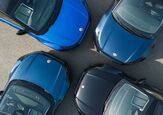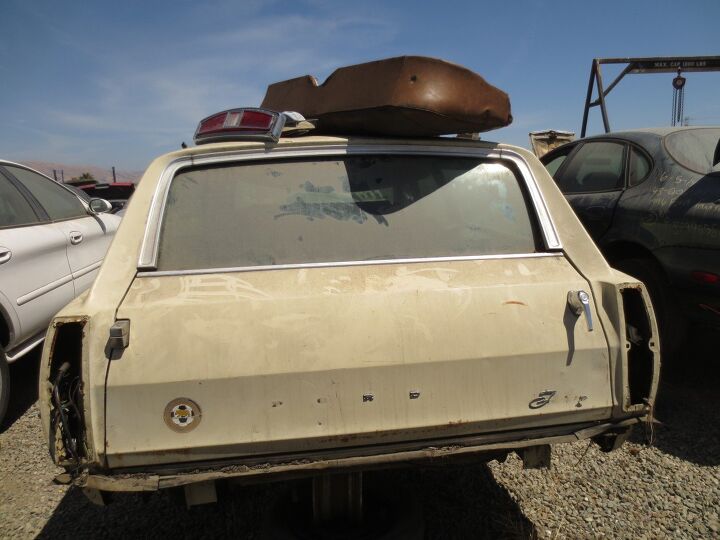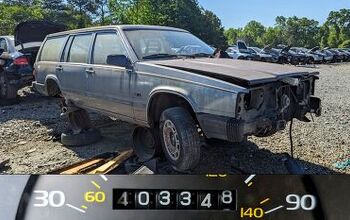Junkyard Find: 1970 Ford Fairlane 500 Station Wagon

We haven’t seen a Ford Fairlane in this series since this ’65 sedan, way back in 2010. We see station wagons here all the time, of course, the last couple being this ’66 Toyota crown and this ’86 Nissan Maxima. Our most recent Detroit station wagon Junkyard Find was this ’72 Pinto (or this ’60 Valiant, if you don’t consider the Pinto to be a proper Detroit station wagon). This ’70 Fairlane is rare indeed; I can’t recall having seen any midsize Ford wagon of this vintage on the street or in the junkyard for many years.
There’s a lot of nostalgia for the big American family wagons among some of us who grew up in the 1960s and 1970s, though most of those cars are the full-sized machines built on the Galaxie/Impala/Fury/Ambassador platforms, not the smaller midsize ones such as this Fairlane. My family never had a station wagon, preferring the Chevy Beauville passenger van as our family-outing-mobile.
Windsor V8 with an enormous AC compressor, the same thing you saw under the hoods of millions of Fairlanes, Montegos, Torinos, Cyclones, and Rancheros of the era.
This one took kids to soccer practice 40 years ago.
Guam pride!
It’s not rusty and wouldn’t be a huge challenge to restore, but the love of old wagons among Generation X types hasn’t translated into much real-world willingness to spend money and time fixing them up.
The ’68 was an earlier generation of this platform, but it had the same “action size” as the ’70.

Murilee Martin is the pen name of Phil Greden, a writer who has lived in Minnesota, California, Georgia and (now) Colorado. He has toiled at copywriting, technical writing, junkmail writing, fiction writing and now automotive writing. He has owned many terrible vehicles and some good ones. He spends a great deal of time in self-service junkyards. These days, he writes for publications including Autoweek, Autoblog, Hagerty, The Truth About Cars and Capital One.
More by Murilee Martin
Latest Car Reviews
Read moreLatest Product Reviews
Read moreRecent Comments
- Ravenuer Not into F1. Started watching NASCAR back when they raced actual cars. (yeah I'm that old). Not any more. They aren't "stock cars" now. Not even close. Even drag races don't interest me anymore. Races are over in 3 seconds.
- Wjtinfwb No confusion on my end, Ghost. The Government has zero role in job creation outside of the legitimate opportunities' created by Government going about it's responsibilities, namely keeping the American people and territory safe from foreign intrusion. Of course, they're failing epically at that but that's a different topic. The American free enterprise system is what enables job creation. Government's role is to stay out of the way of that system, but they seem incapable of doing so. Oil & Gas exploration is just one example. If a National Job Policy is what you're looking for, there are other countries that will be happy to accept your application for residency.
- Michael Smith I drive 100-300 miles a day in new BMWs, Mercedes-Benzes, and GM SUVs. Some are already equipped with automatic braking.It's the first thing I turn off when I start the car.I've had experiences where (as the author notes) the system gave false alarms and stabbed the brake pedal, threatening my ability to control the car.Further, every driver encounters situations where, for example, legal following distance must be momentarily compromised in order to avoid a difficult situation. When the system intervenes, it disrupts the driver's plan of action. This can lead to a collision as the driver has to suddenly react not to his surroundings, but to the system.Not only is automatic braking an insult to skilled drivers, it's dangerous to everyone.
- Dave M. My hipster daughter is greatly into it. We watched the race together this weekend. It was interesting but I'm not devoted to it like she is. She'll be at the Austin race in October.
- Bd2 I'll watch F1 when Kia and/or Hyundai pony (pun intended) up the cash to field a class leading team. Hyundai is leading many series with the Elantra N with it's incredible 350HP Smartstream-R engine.





















































Comments
Join the conversation
I'm surprised that no one has yet commented on how the 1966-70 Ford Fairlane and Torino station wagons shared their bodyshell with the 1966-70 Ford Falcon station wagons. I think everyone knows how the original 1962 mid-sized Ford Fairlane and Mercury Meteor chassis were based on the chassis from the Ford Falcon and the Comet, but were both wider and had longer wheel-bases. When the Falcon was redesigned for the 1966 model year, it was moved to the wider chassis of the Fairlane, although Falcon 2 and 4-door sedans had a shorter wheelbase than Fairlane 2 and 4-door sedans, hardtop coupes and convertibles. (The 1966 model year also saw the Mercury Comet move from being a compact car to sharing its chassis and wheelbase with the mid-sized Ford Fairlane.) 1966 Falcon and Fairlane station wagon were built on a wheelbase sized between the other Falcons and Fairlanes. They shared the same wheelbase and body-shell. The only difference was the front-end clip. The 1966 Mercury Comet station wagon shared the same wheelbase as the Fairlane and Falcon station wagons, as did the Ford Ranchero. (You will remember how the 1966 Ranchero used the Falcon front-end clip, while the 1967 Ranchero used the Fairlane front-end clip. There really weren't many changes other than the front-end clip, but it was felt that the Fairlane styling would allow it to compete better with the Chevelle-based El Camino.) I remember how back in the late 1960s Consumer Reports classified the Falcon station wagon as a "mid-sized" station wagon along with the Fairlane and it really surprised people who considered it more of a rival to the Rambler American because of how the Falcon was marketed. In 1970 the Ford Fairlane and Torino, and the Mercury Montego and Cyclone all got new sheet metal, wagons included, but were still built on the same basic chassis as before. There was a short-run of early 1970 Falcons that were nearly identical to the 1969 Falcons, then there was the 1970 1/2 Ford Falcon that was really just a stripped-down Ford Fairlane. In 1971, the Ford Torino and Mercury Montego and Cyclone continued with only minor trim changes, but the Falcon and Fairlane names were dropped.
Johnster thanx for bringing this up, as briefly I owned a 1966 Falcon wagon , a pretty basic one with " three-on-the-tree and no A.C." that I bought for maybe $ 100 in Austin in 1976 . It really was more of a mid-size car , not like the older Falcons . Shortly after I bought it , it caught fire on the recently opened MoPac freeway . I left it smoldering by the side of the road and walked home .